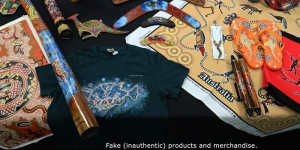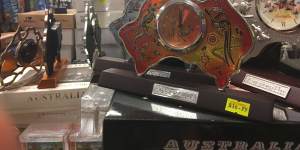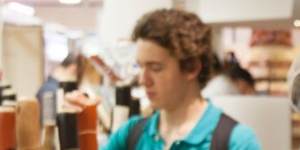They are urging the Turnbull government to crack down on the industry that they say is robbing Indigenous artists of a much-needed stream of income.

Examples of souvenirs featuring fake or unlicensed Indigenous art and designs.Indigenous Art Code
Souvenir shops in Sydney's The Rocks district,Melbourne's Flinders Street and tourism hot spots such as Cairns are selling mass-produced boomerangs and didgeridoos made from non-traditional materials such as bamboo,while plates,mugs,clothing items and key rings feature patterns and designs which are marketed as Indigenous.
But much of it is mass produced either offshore or in Australia by non-Indigenous commercial outfits.

Examples of souvenirs featuring fake or unlicensed Indigenous art and designs.Supplied
"A mystery shopping exercise in tourist locations in various capital cities found very large numbers of such items and estimates suggest this is a multimillion-dollar market,"the Indigenous Art Centre Alliance wrote in its submission to a parliamentary inquiry ordered by the Indigenous Affairs Minister,Nigel Scullion.
"The issue of inauthentic[sic] Aboriginal and Torres Strait Islander art impacts on the copyright,cultural rights and livelihoods of thousands of Indigenous people and their communities. It is widespread and pervasive."
The Indigenous Art Centre Alliance,which represents 500 artists working across far north Queensland,told the inquiry it believed the figure was closer to 90 per cent in tourist shops in and around Cairns where international tourists are a lucrative source of income for local businesses.
Organisations familiar with the tourist market in Sydney,Melbourne and Brisbane have told the inquiry the amount of arts and crafts of dubious origin but marketed as Aboriginal is as high as 80 per cent.

Reputable dealer:genuine didgeridoos for sale at the Spirit Gallery. The Rocks. They buy directly from Indigenous artists.Fiona Morris
Artists'representatives have told the inquiry the tourist-focused arts and crafts industry robs Indigenous artists of the chance to make a living because fakes are cheaper to make and faster to produce.
Tighter restrictions on the authentification of Indigenous fine art works were introduced a decade ago as part of an attempt to protect artists.
Reputable galleries now provide documentation of a work's provenance as well as its history if it has been sold more than once.
But there are no such safeguards in the tourist-focused arts and crafts industry,which relies on sales of quantity rather than quality.
Attempts to introduce a"label of authenticity"scheme in 1999 were abandoned after criticisms that the then Howard government had not adequately consulted artists.
But now there is talk of resurrecting a similar scheme.
Senator Scullion has asked a parliamentary committee to look at the prevalence of Indigenous style arts and crafts and the possibility of greater protections for artists.
But opinion is divided when it comes to possible solutions.
The Arts Law Centre of Australia,which provides legal advice to Aboriginal and Torres Strait Islander artists,is pushing for a ban on the sale of"fake"products as the simplest way to address the issue.
"In many Indigenous communities,the expression of culture through the creation of artworks,craft and product is a singular source of non-government income for an extended family or community. A market full of'fake'product suppresses the value of such expression,and significantly undermines the capacity for the generation of independent income for those Indigenous people and their communities,"it said.
"Our view is that changing the law to restrict the prevalence of inauthentic[sic] art will enhance consumer confidence in the market. This will likely lead to a growth in the trade of authentic artworks,and an increase in healthy competition between authentic Indigenous arts businesses."
It points out that although many products get around consumer laws with labels saying the item has been made overseas or is"inspired"by Indigenous art,Indigenous artists'intellectual copyright is still being breached.
To further complicate matters,copyright expires 70 years after an image was first produced,which means artists or traditional owners have no legal recourse when patterns or motifs are reproduced for the tourist market.
There also is no body policing copyright,which means artists,many of whom have limited resources and do not have English as their first language,must pursue possible infringements themselves,a costly and difficult process.
However,the Aboriginal Art Association of Australia says it would prefer to see authentic items labelled.
"Total prohibition at the border is unrealistic,"the association said,"but even if it could work,it would close down tourist retail outlets which are needed by Aboriginal artists to distribute authentic product. That's why properly enforced,accurate labels that specify'Aboriginal made','Aboriginal designed',and'not made or designed by an Aboriginal person'make more sense than banning inauthentic tourist product altogether."
The inquiry will make recommendations next year.
Doing it the right way
Reno Safarian,owner of the Spirit Gallery in The Rocks,ensures their products are authentic by buying directly from Aboriginal artists and community art centres.
"We have all the information,artist profiles and certificates[of authentication] for our artworks,"Mr Safarian said.
"Even lots of our'Australian-made gift range',such as T-shirts and scarves have information of the artist,as a lot of people will ask if it is made[in Australia] ... So we're prepared for that."
Mrr Safarian said cheaper"fake"products remain common in tourist hot spots,which are particularly problematic where artists are not credited.
"The real problem is the fake craft,the fake boomerangs,drilled out didgeridoos from Indonesia,"he said.
"Often it's not labelled as Aboriginal art - so no one is saying it's authentic,but they are implying it. Tourists may not ask,so it just gets sold as Aboriginal art.
"It's been going on for a long time,and it will be hard to get control over - particularly in cases where it is not sold as'authentic'."
Mr Safarian said he had even seen souvenir stores which sell products which"mimic or pretend to be Aboriginal art",even though they are not traditionally used by Aboriginal communities - such as rain sticks.